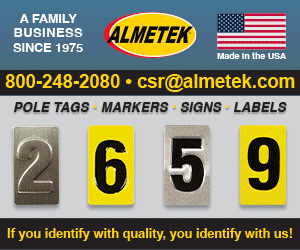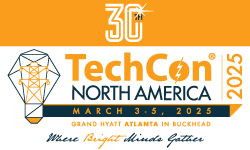Arc Flash safety has become as important a topic in the industry as electric shock protection. Few electrical workers would consider working on a 13.8kV system without their proper voltage rated gloves. Similarly, many workplaces are looking towards their consultants, electrical engineers, clothing manufacturers and the standards for guidance on creating an Arc Flash safe workplace. However, there are several myths, which need to be addressed:
MYTH: Arc Flash explosions do not happen… I have never seen one.
REALITY: Hopefully, most electrical workers will never see and an flash accident. However, electrical work by nature is dangerous due to the high energy levels involved and the fact that until an accident occurs, electricity is odorless, colorless and essentially invisible. Electrical workers have chosen the third most dangerous profession according to recent OSHA statistics. There are 10 OSHA reportable Arc Flash incidents involving more than one fatality everyday in the USA. Studies indicate that up to 80% of all Electrical Worker injuries are not due to shock (passage of electrical current through the body) but due to external burn injuries created by the intense radiant heat energy of an electrical arc explosion.
MYTH: There is nothing anyone can do to protect against an Arc Flash explosion
REALITY: There is a great deal that can be done to prevent an Arc Flash explosion and to protect personnel if they are exposed to an Arc Flash. The National Fire Protection Association (NFPA) developed NFPA 70E “Standard for Electrical Safety in the Workplace” to reduce the number of accidents which occur in the workplace. The standard provides guidance on Personal Protective Equipment (PPE) selection to greatly reduce or avoid injury in the event of an Arc Flash accident. An Electrical Safety program is like the four legs of a chair… each one indispensable to a safe workplace:
Removal of any one of the “legs of the chair” could lead to severe injury and death.
MYTH: Will Street Clothes made of cotton or other natural fibers protective me?
REALITY: Cotton and wool definitely are flammable fibers and can ignite if exposed to the intense radiant energy of an Arc Flash. When clothing ignites and burns on the wearer’s body, large areas of the body surface can sustain 2nd and 3rd degree burn injuries. Burn injury can take place in portions of the body that were not initially exposed by the arc. As the combustion of cotton or other flammable clothing continues to spread to additional areas of the body, the extent of the burn injuries increases. Flame Resistant (FR) clothing which meets the requirements of ASTM F1506 and NFPA 70E will not ignite and continue to burn on the human body, and can additionally provide thermal protection for the areas of the body that it covers. Multiple layers of lightweight fabric can be designed to provide the level of protection needed to address a wide range of Arc Flash hazards. The NFPA 70E standard provides guidance on how to select the appropriate PPE, which matches the level of the Arc Flash hazard determined for the electrical task being performed.
MYTH: Spectacles and Sunglasses will protect me from the heat of an Arc Flash exposure
REALITY: There are many types of safety spectacles and sunglasses. None of these have been assigned an Arc Rating. The actual surface area protected by a pair of spectacles is quite limited (only a small fraction of your face). Because there is no Arc Rating, the user cannot know what protection is provided. Only an Arc Rated Faceshield or Hood can provide a designated level of protection against the thermal energy of an electric arc and be matched to the Arc Flash hazard determined for the task being performed.
MYTH: I wear a faceshield… that should be enough
REALITY: It depends upon the faceshield. In the marketplace, there are some Arc Rated Faceshields. Arc Flash faceshields are required to be tested to ASTM F2178 test method to determine their arc protective rating. Arc Rated Faceshields are typically used for electrical work where the hazard is below 8 calories/ cm2 or NFPA 70E Hazard Risk Category #1 and #2. However, many in the industry continue to use clear polycarbonate faceshields as arc flash protection. Oberon conducted research in 2003 on Clear Polycarbonate faceshields and determined that clear face shields or clear hood windows do not offer any significant degree of protection for the face during an arc flash event. The reason for anecdotal evidence regarding protection provided by clear shield windows remains unclear. There may be cases in which a worker was facing away from the arc source when the arc flash event occurred. Or the face area may have been exposed to lower levels of incident heat energy than other parts of the body giving the impression that a clear shield window had provided protection. Whatever the case, arc flash testing indicates that even at the very low exposure level of 2.7 cal/cm2, the eye and mouth sensors of the test apparatus headform indicate a 2nd degree burn injury.
MYTH: I wear a faceshield… when would I need a hood?
REALITY: An Arc Rated faceshield provides effective protection for the areas that it covers, i.e. the face and to some degree the frontal neck area. Depending on the design, convective heat can travel under the face shield and cause burns even to the face especially for higher-level Arc Flash exposures. Of course, a face shield cannot protect the sides and back of the head or the neck. An Arc Rated Hood provides uniform protection for the entire head and neck. Further, the use of an Arc Rated faceshield is limited to tasks designated by NFPA 70E Hazard Risk Category (HRC) #2. For tasks designated by HRC 2*, HRC 3 or HRC 4, the use of full hood is required.
MYTH: FR Clothing is all the same.
REALITY:There are two basic types of FR Clothing.
It has been shown that the FRT Cotton clothing can lose their flame resistance if laundered incorrectly, e.g. with a bleach. With inherently FR clothing, there is no treatment so there is nothing that can be washed off.
MYTH: ATPV = 100% Protection
REALITY: The definition of Arc Thermal Protective Value (ATPV) recently approved for arc test method ASTM F1959 is “the incident energy on a fabric or material that results in a 50% probability that sufficient heat transfer through the tested specimen is predicted to cause the onset of a second- degree skin burn injury based on the Stoll1 curve.” The revised data analysis method also provides the incident energy in cal/cm2 for lower probabilities of the onset of a 2nd degree burn injury, e.g. from a 40% probability down to a 1% probability of sustaining a burn injury. While most people would not consider a 50% chance of injury to be sufficient protection, limiting the use of a garment to the better protection probabilities, and their corresponding energy levels, will reduce your chance of burn injury.
MYTH: Aluminized clothing is an effective choice for protection from Arc Flash hazards.
REALITY: Aluminized clothing does work effectively to block radiant energy from an Arc Flash event; however, since aluminum is a good conductor of electricity, the aluminized fabric can increase the probability of an Arc Flash accident. Oberon has demonstrated in the Kinectrics arctesting laboratory that aluminized fabric can act to initiate an arc by reducing the air gap between the electrodes used in the ASTM F1959 arc test method. Similarly, aluminized fabric could cause the initiation of an arc accident by reducing the air gap between conductors in electrical equipment.
MYTH: I am confused by the Table 3.3.9.3 in NFPA 70E. What exactly is a Hazard/Risk Category?
REALITY: To identify ranges of hazards, NFPA created Hazard/Risk Categories. This was intended to make the selection of PPE simpler for the consumer. However, the Table 3.3.9.3 in the previous version of 70E seemed to create more confusion for the users than clarification. The table identifies energy levels corresponding to each of the 4 Hazard/Risk levels. Unfortunately, it goes further to state minimum energy levels or Arc Ratings. Did the Table mean that the hazard has a minimum energy level or the clothing has a minimum protection level?
The fact is the table was identifying the minimum protection level offered by clothing for each Hazard/Risk Category (in the case of HRC #3 = 25cal/cm2) for maximum task energy levels (25cal/cm2). In other words, if the task you are performing in classified by the NFPA 70E tables as a HRC #3, this means the task has an energy level less than 25cal/cm2. To insure your protection, you must use, according to NFPA 70E and Table 3.3.9.3, Arc Rated Hood and Clothing with a minimum Arc Rating of 25cal/cm2.
If you conduct your own hazard analysis for a task, which is preferable since it is more representative and accurate for the task in your work place than the NFPA 70E table can be, then PPE can be selected with an arc rating in excess the hazard level of the task to be performed.
Fortunately, the table has been rewritten in the new version of 70E to be clearer. In the new 2004 Edition of NFPA 70E, the same Table which is now designated Table 130.7(C)(11), the description has been changed to “Required Minimum Arc Rating of PPE (cal/cm2)”. With this new wording, it will hopefully be clearer to the users of the standard.
Many excellent resources are available to assist you in your efforts to create a safe workplace. First, NFPA 70E standard itself can be purchased from the NFPA website. The standard is available in English and Spanish! There are seminars covering Arc Flash standards and workplace safety. Additionally, there are consultants & software to assist you in your hazard assessment, identifying the level of hazard of your particular task(s). “Safety is no accident” is an expression often used. Knowledge, training and proper PPE can make the difference between going home for dinner … or not.
The Oberon ArcTrainer CD-ROM, covering the Electrical Safety Standards and Arc PPE can be ordered FREE over the Internet at http://www.arcflash.com/elecCD
ABOUT THE AUTHOR
Randell B Hirschmann is the Director of Marketing for Oberon Company div Paramount Corp, which has over 60 years experience in Personal Protective products.
Thomas E. Neal, PhD (Neal Associates Ltd) was the Technology Manager of DuPont’s Thermal Testing Laboratory from 1994 through 1999. He has over twenty-five years of experience in high performance fibers, fabrics and protective clothing. He has been a leader in the development of industry standards related to electric arc flash hazard analysis and the application of flame resistant protective apparel for arc flash and flash fire hazards.
Copies of the NFPA 70-2000 Standard can be purchased directly from NFPA at the web site http://www.nfpa.org/catalog (Search for 70E04 for English version of 70E-2004 or 70E00E for the Spanish version of 70E-2000).
For more information about Arc Flash PPE, Electrical Safety Standards, Arc Flash Protective Equipment or available Hazard Assessment resources, please contact Randell Hirschmann at RHirschmann@oberoncompany.com or visit the web site at http://www.arcflash.com
Footnotes:
[1] Derived from: Stoll, A.M. and Chianta, M.A., "Method and Rating System for Evaluations of Thermal Protection", Aerospace Medicine, Vol 40, 1969, pp. 1232-1238 and Stoll, A.M. and Chianta, M.A., “Heat Transfer through Fabrics as Related to Thermal Injury”, Transactions – New York Academy of Sciences, Vol 33 (7), Nov. 1971, pp. 649-670.
MYTH: Arc Flash explosions do not happen… I have never seen one.
REALITY: Hopefully, most electrical workers will never see and an flash accident. However, electrical work by nature is dangerous due to the high energy levels involved and the fact that until an accident occurs, electricity is odorless, colorless and essentially invisible. Electrical workers have chosen the third most dangerous profession according to recent OSHA statistics. There are 10 OSHA reportable Arc Flash incidents involving more than one fatality everyday in the USA. Studies indicate that up to 80% of all Electrical Worker injuries are not due to shock (passage of electrical current through the body) but due to external burn injuries created by the intense radiant heat energy of an electrical arc explosion.
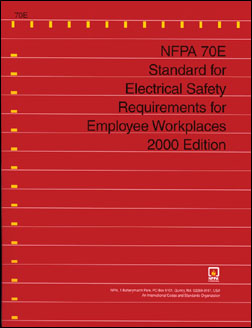
MYTH: There is nothing anyone can do to protect against an Arc Flash explosion
REALITY: There is a great deal that can be done to prevent an Arc Flash explosion and to protect personnel if they are exposed to an Arc Flash. The National Fire Protection Association (NFPA) developed NFPA 70E “Standard for Electrical Safety in the Workplace” to reduce the number of accidents which occur in the workplace. The standard provides guidance on Personal Protective Equipment (PPE) selection to greatly reduce or avoid injury in the event of an Arc Flash accident. An Electrical Safety program is like the four legs of a chair… each one indispensable to a safe workplace:
- A knowledgeable electrical worker, qualified to perform the task
- Safe work practices & procedures in place to reduce the likelihood or severity of an injury
- Engineering Controls (Hardware) in place to reduce the extent/level of the hazard
- Personal Protective Equipment, including clothing and gloves, to protect the worker in the event an arc occurrence
Removal of any one of the “legs of the chair” could lead to severe injury and death.
MYTH: Will Street Clothes made of cotton or other natural fibers protective me?
REALITY: Cotton and wool definitely are flammable fibers and can ignite if exposed to the intense radiant energy of an Arc Flash. When clothing ignites and burns on the wearer’s body, large areas of the body surface can sustain 2nd and 3rd degree burn injuries. Burn injury can take place in portions of the body that were not initially exposed by the arc. As the combustion of cotton or other flammable clothing continues to spread to additional areas of the body, the extent of the burn injuries increases. Flame Resistant (FR) clothing which meets the requirements of ASTM F1506 and NFPA 70E will not ignite and continue to burn on the human body, and can additionally provide thermal protection for the areas of the body that it covers. Multiple layers of lightweight fabric can be designed to provide the level of protection needed to address a wide range of Arc Flash hazards. The NFPA 70E standard provides guidance on how to select the appropriate PPE, which matches the level of the Arc Flash hazard determined for the electrical task being performed.

MYTH: Spectacles and Sunglasses will protect me from the heat of an Arc Flash exposure
REALITY: There are many types of safety spectacles and sunglasses. None of these have been assigned an Arc Rating. The actual surface area protected by a pair of spectacles is quite limited (only a small fraction of your face). Because there is no Arc Rating, the user cannot know what protection is provided. Only an Arc Rated Faceshield or Hood can provide a designated level of protection against the thermal energy of an electric arc and be matched to the Arc Flash hazard determined for the task being performed.
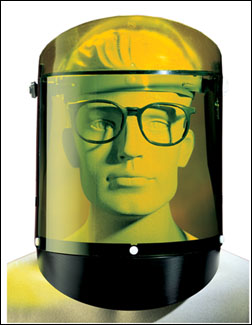
MYTH: I wear a faceshield… that should be enough
REALITY: It depends upon the faceshield. In the marketplace, there are some Arc Rated Faceshields. Arc Flash faceshields are required to be tested to ASTM F2178 test method to determine their arc protective rating. Arc Rated Faceshields are typically used for electrical work where the hazard is below 8 calories/ cm2 or NFPA 70E Hazard Risk Category #1 and #2. However, many in the industry continue to use clear polycarbonate faceshields as arc flash protection. Oberon conducted research in 2003 on Clear Polycarbonate faceshields and determined that clear face shields or clear hood windows do not offer any significant degree of protection for the face during an arc flash event. The reason for anecdotal evidence regarding protection provided by clear shield windows remains unclear. There may be cases in which a worker was facing away from the arc source when the arc flash event occurred. Or the face area may have been exposed to lower levels of incident heat energy than other parts of the body giving the impression that a clear shield window had provided protection. Whatever the case, arc flash testing indicates that even at the very low exposure level of 2.7 cal/cm2, the eye and mouth sensors of the test apparatus headform indicate a 2nd degree burn injury.
MYTH: I wear a faceshield… when would I need a hood?
REALITY: An Arc Rated faceshield provides effective protection for the areas that it covers, i.e. the face and to some degree the frontal neck area. Depending on the design, convective heat can travel under the face shield and cause burns even to the face especially for higher-level Arc Flash exposures. Of course, a face shield cannot protect the sides and back of the head or the neck. An Arc Rated Hood provides uniform protection for the entire head and neck. Further, the use of an Arc Rated faceshield is limited to tasks designated by NFPA 70E Hazard Risk Category (HRC) #2. For tasks designated by HRC 2*, HRC 3 or HRC 4, the use of full hood is required.
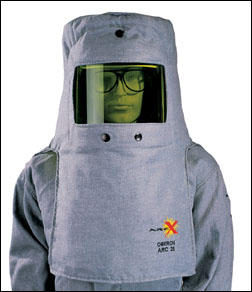
MYTH: FR Clothing is all the same.
REALITY:There are two basic types of FR Clothing.
- Flame Retardant Treated (FRT) clothing, which is simple cotton made flame resistant due to a flame retardant chemical treatment applied to the fabric
- Inherently Flame Resistant clothing, which is made from fabrics and fibers with a chemical structure that will not burn in air.
It has been shown that the FRT Cotton clothing can lose their flame resistance if laundered incorrectly, e.g. with a bleach. With inherently FR clothing, there is no treatment so there is nothing that can be washed off.
MYTH: ATPV = 100% Protection
REALITY: The definition of Arc Thermal Protective Value (ATPV) recently approved for arc test method ASTM F1959 is “the incident energy on a fabric or material that results in a 50% probability that sufficient heat transfer through the tested specimen is predicted to cause the onset of a second- degree skin burn injury based on the Stoll1 curve.” The revised data analysis method also provides the incident energy in cal/cm2 for lower probabilities of the onset of a 2nd degree burn injury, e.g. from a 40% probability down to a 1% probability of sustaining a burn injury. While most people would not consider a 50% chance of injury to be sufficient protection, limiting the use of a garment to the better protection probabilities, and their corresponding energy levels, will reduce your chance of burn injury.
MYTH: Aluminized clothing is an effective choice for protection from Arc Flash hazards.
REALITY: Aluminized clothing does work effectively to block radiant energy from an Arc Flash event; however, since aluminum is a good conductor of electricity, the aluminized fabric can increase the probability of an Arc Flash accident. Oberon has demonstrated in the Kinectrics arctesting laboratory that aluminized fabric can act to initiate an arc by reducing the air gap between the electrodes used in the ASTM F1959 arc test method. Similarly, aluminized fabric could cause the initiation of an arc accident by reducing the air gap between conductors in electrical equipment.
MYTH: I am confused by the Table 3.3.9.3 in NFPA 70E. What exactly is a Hazard/Risk Category?
REALITY: To identify ranges of hazards, NFPA created Hazard/Risk Categories. This was intended to make the selection of PPE simpler for the consumer. However, the Table 3.3.9.3 in the previous version of 70E seemed to create more confusion for the users than clarification. The table identifies energy levels corresponding to each of the 4 Hazard/Risk levels. Unfortunately, it goes further to state minimum energy levels or Arc Ratings. Did the Table mean that the hazard has a minimum energy level or the clothing has a minimum protection level?
The fact is the table was identifying the minimum protection level offered by clothing for each Hazard/Risk Category (in the case of HRC #3 = 25cal/cm2) for maximum task energy levels (25cal/cm2). In other words, if the task you are performing in classified by the NFPA 70E tables as a HRC #3, this means the task has an energy level less than 25cal/cm2. To insure your protection, you must use, according to NFPA 70E and Table 3.3.9.3, Arc Rated Hood and Clothing with a minimum Arc Rating of 25cal/cm2.
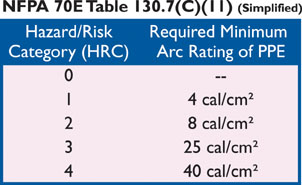
If you conduct your own hazard analysis for a task, which is preferable since it is more representative and accurate for the task in your work place than the NFPA 70E table can be, then PPE can be selected with an arc rating in excess the hazard level of the task to be performed.
Fortunately, the table has been rewritten in the new version of 70E to be clearer. In the new 2004 Edition of NFPA 70E, the same Table which is now designated Table 130.7(C)(11), the description has been changed to “Required Minimum Arc Rating of PPE (cal/cm2)”. With this new wording, it will hopefully be clearer to the users of the standard.
Many excellent resources are available to assist you in your efforts to create a safe workplace. First, NFPA 70E standard itself can be purchased from the NFPA website. The standard is available in English and Spanish! There are seminars covering Arc Flash standards and workplace safety. Additionally, there are consultants & software to assist you in your hazard assessment, identifying the level of hazard of your particular task(s). “Safety is no accident” is an expression often used. Knowledge, training and proper PPE can make the difference between going home for dinner … or not.
The Oberon ArcTrainer CD-ROM, covering the Electrical Safety Standards and Arc PPE can be ordered FREE over the Internet at http://www.arcflash.com/elecCD
ABOUT THE AUTHOR
Randell B Hirschmann is the Director of Marketing for Oberon Company div Paramount Corp, which has over 60 years experience in Personal Protective products.
Thomas E. Neal, PhD (Neal Associates Ltd) was the Technology Manager of DuPont’s Thermal Testing Laboratory from 1994 through 1999. He has over twenty-five years of experience in high performance fibers, fabrics and protective clothing. He has been a leader in the development of industry standards related to electric arc flash hazard analysis and the application of flame resistant protective apparel for arc flash and flash fire hazards.
Copies of the NFPA 70-2000 Standard can be purchased directly from NFPA at the web site http://www.nfpa.org/catalog (Search for 70E04 for English version of 70E-2004 or 70E00E for the Spanish version of 70E-2000).
For more information about Arc Flash PPE, Electrical Safety Standards, Arc Flash Protective Equipment or available Hazard Assessment resources, please contact Randell Hirschmann at RHirschmann@oberoncompany.com or visit the web site at http://www.arcflash.com
Footnotes:
[1] Derived from: Stoll, A.M. and Chianta, M.A., "Method and Rating System for Evaluations of Thermal Protection", Aerospace Medicine, Vol 40, 1969, pp. 1232-1238 and Stoll, A.M. and Chianta, M.A., “Heat Transfer through Fabrics as Related to Thermal Injury”, Transactions – New York Academy of Sciences, Vol 33 (7), Nov. 1971, pp. 649-670.




